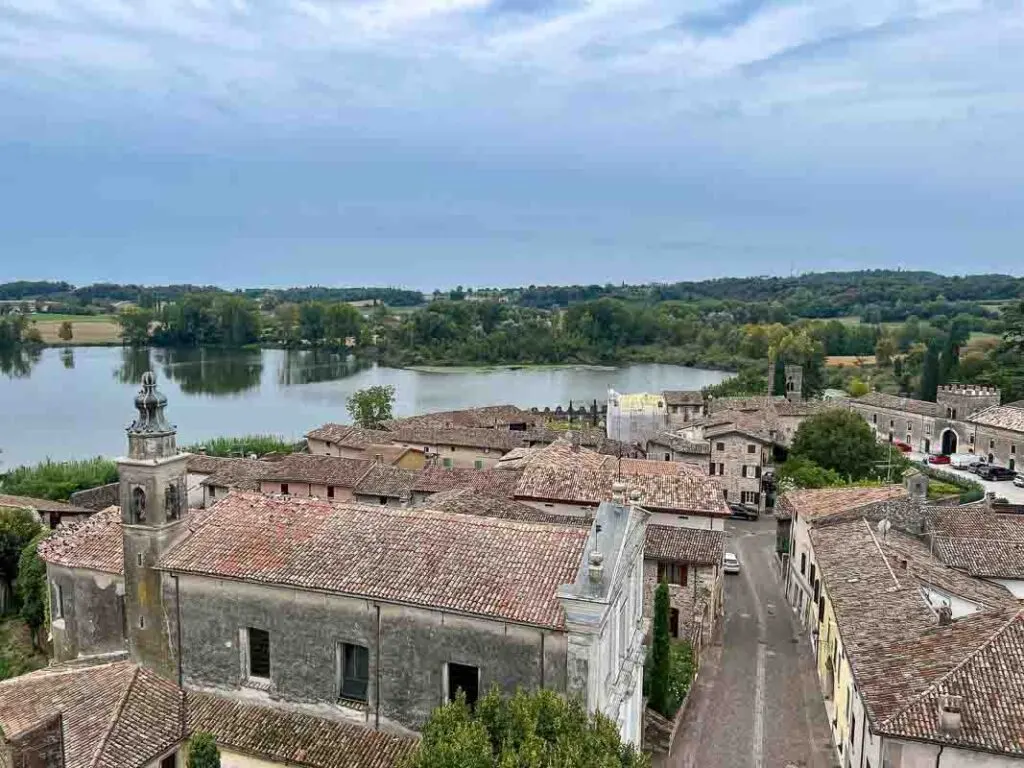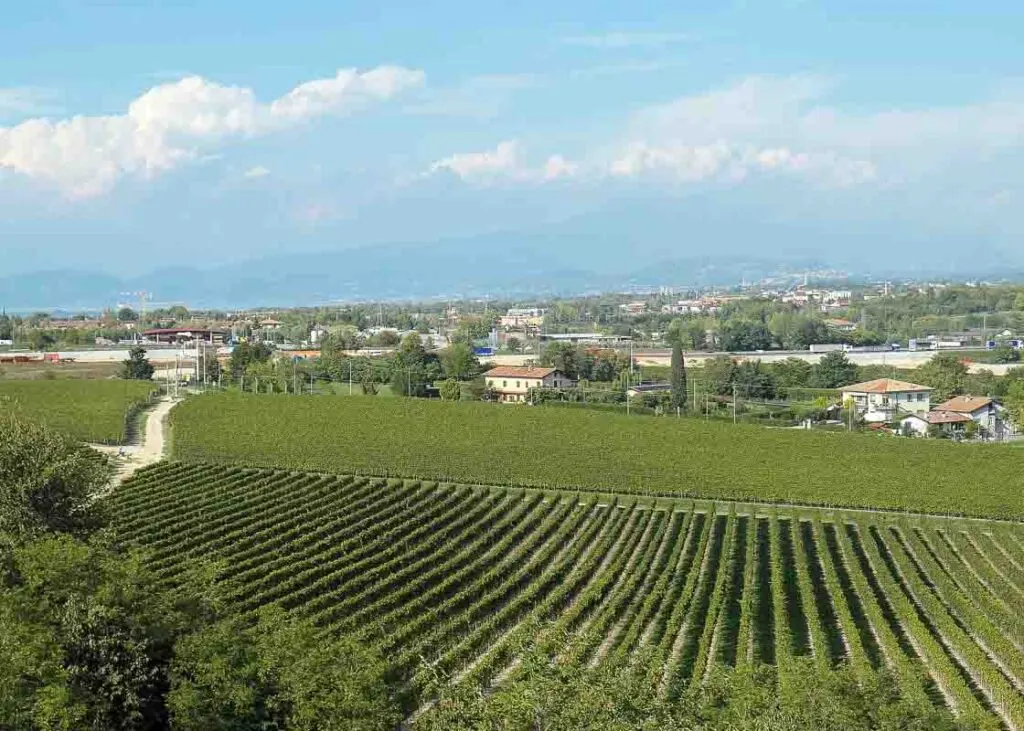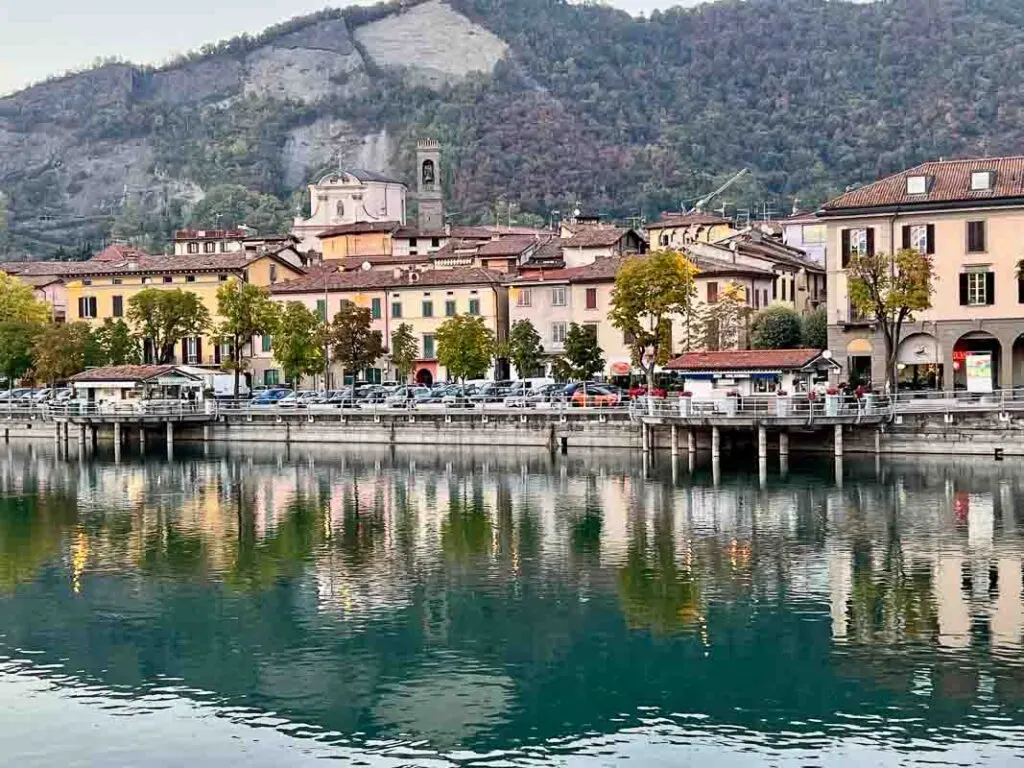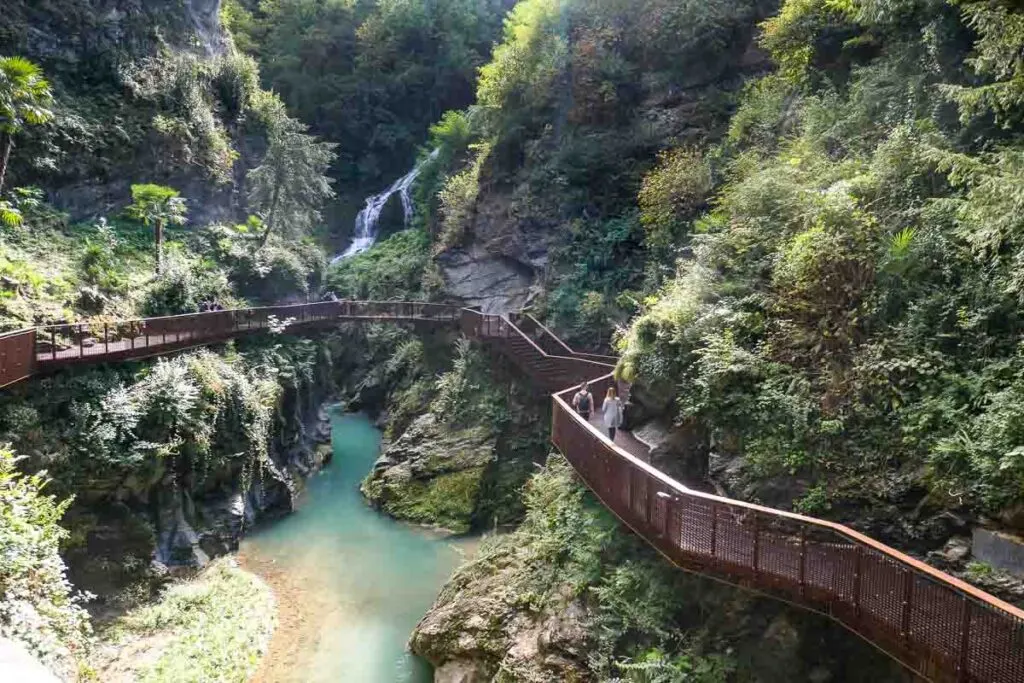
This post may contain compensated links. This means if you click on a link and make a purchase, this site may receive a small commission. Thanks for your support. Find more info in my disclaimer.
One dreamy Italian road trip, ten beautiful borghi in Lombardia and more gorgeous Italian food than you can shake a bread stick at…
Contents
I’m just back from an epic tour of Italy, exploring the beautiful borghi of Lombardy, its ancient castles, lakes, mountains and waterfalls. I may also have consumed more than my fair share of incredible Lombardian food and wine. Read on to discover some of the best villages, hamlets and borghi to visit in Lombardy, Italy.
What is a borgo or borghi?
But first, what is a borgo, or borghi (plural)? Borghi are beautiful little villages in Italy dating back to the middle ages. Some are fortified and perched on a hill, they could be by a lake, ensconced in a mountain range, or sitting by a river in a lush green valley. Many are steeped in history, some have amazing natural wonders, others are rich in culture, art and cuisine. All are utterly beguiling.
Where is Lombardy?
Lombardy is a region in northern Italy known as Lombardia in Italian. It borders Switzerland to the north and Emilia-Romagna to the south. To the east is Trentino-Alto Adige and Veneto and to the west you’ll find Piedmont. You’ll find some of the most beautiful villages in Italy in Lombardy.
The capital of Lombardy is Milan, the cultural and fashion hub of Italy and the area is thought to be the wealthiest in the country.
The Lombardy region is more off the beaten track than other Italian areas. It’s much less visited than Veneto, Tuscany and Lazio (Rome) which makes it less touristy than some parts of Italy.

What is Lombardy famous for?
Lombardy is known for its gorgeous lakes. Although it doesn’t have a coastline, it more than makes up for that by having some of the most beautiful lakes in Italy. Lombardia also borders the Italian Alps which is home to heaps more stunning scenery.
As well as historic villages, towns and cities, Lombardy is home to more UNESCO World Heritage Sites than anywhere else in Italy.
The regional gastronomy has an age-old tradition of excellent food and wine production drawn from its rich, fertile landscape. Lombardy is known for its famous Franciacorta sparkling wines, bresaola – a dry cured beef, speciality stuffed pastas, polenta, panettone, cheese and much more.
How to get to Lombardy in Italy?
By air: From outside Italy, Lombardy is easy to reach from all of Europe. Milan is served by three airports; Milan Malpensa, Milan Linate and Orio al Serio International Airport (Bergamo). Choose from a range of budget airlines and frequent flights. We flew from London Gatwick to Milan Malpensa with Wizz Air. Easyjet also have frequent flights to Lombardy.
>>> Check the best flights on Skyscanner here.
By train: Milan serves as a well located hub for high speed trains across Italy and as a good network for Lombardy.
By Car: The A4 connects Turin and Milan with Bergamo, Brescia, the A7 heads south and the A9 goes to Como and the north.
We hired a car to get around Lombardy which was more convenient for all the places we wanted to see on our roadtrip. We occasionally used the train and ferry.

10 Beautiful Places to Visit in Lombardy, Italy
There are so many gorgeous places to visit and amazing things to do in Lombardy that every kind of traveller will find something to love. Whether it’s outdoor adventure, nature, amazing food or an immersion in history, art and culture.
Lombardy’s Borghi offer a slower pace of life and an authentic flavour of Italy. I loved exploring these off the beaten track places. They were less touristy and far removed from the busy scenes found in places like Venice, Rome or the packed towns of the Amalfi Coast.
All the villages in this article have been awarded the Orange Flag of the Italian Touring Club, an environmental tourism quality mark for villages offering excellent quality and hospitality.
If the borgo is also a member of the most beautiful villages in Italy (I Borghi più belli d’Italia), I’ve mentioned it in the relevant section.
Our route through Lombardy
It’s logical that I follow our road trip route as I share these beautiful places to visit in Lombardy. We drove to Lake Garda from Milan Malpansa airport and then looped back via Lake Iseo and Lake Como. There’s a map of Lombardy at the end of this post to help you pinpoint them all if you’re thinking of planning your own visit.
Eastern Lombardy, south of Lake Garda
South of Lake Garda, in an area called the Morainic hills, is a region of rolling hills, vineyards, castles and gorgeous medieval villages. These historic hamlets are all less than half an hour away from the south shores of Lake Garda. Let’s start with one of the most beautiful villages to visit in Lombardy.
Castellaro Lagusello

This charming Lombardian village is a fortified hamlet which sits on a small hill overlooking a natural heart-shaped lake. Surrounded by beautiful countryside, the village has remained unchanged for centuries and you couldn’t hope to find a more enchanting place.
Castellaro Lagusello dates back to the 12th century when it was built by the Scaliger dynasty due to its strategic position.
Many of the castle walls and their walkways are still intact and four of the original ten towers remain along with archways which form the entrance to the hamlet. The best way to explore the village is to wander through its medieval lanes and cobblestoned alleyways. I loved photographing its ancient archways and pretty piazzas.
Catch a glimpse of the heart-shaped lake by climbing the Bell Tower. From this vantage point you’ll also see over the terracotta rooftops of the borgo and out over the surrounding countryside and vineyards.
The parish church of San Nicola di Bari houses paintings by Agostino Ugolini and Cignaroli. Don’t miss the 15th-century painted and gilded wooden sculpture of the Madonna and Child.
A short 4.5 km hike or bike ride around the perimeter of the village through the Moraine Complex of Castellaro Lagusello’ brings lovely views of the village as well as some Bronze Age discoveries. There’s evidence of pile dwellings forming a settlement by the lake. The pile dwellings form part of a UNESCO World Heritage Site covering 19 similar sites in Italy.
Castellaro Lagusello is officially one of the most beautiful villages in Italy (I Borghi più belli d’Italia) and I can see why. The village has also been awarded the Orange Flag (Bandiere Arancioni) by Orange Flag of the Italian Touring Club in recognition of its excellence and quality in tourism.
Where to Stay in Castellaro Lagusello

We stayed in one of the oldest buildings in the village which is a wonderful way to immerse yourself in the history of the area. Antica Dimora dell’Ortolano is an authentic B&B and made for an unforgettable stay. Breakfast is served downstairs in a small café bar which was one of our favourite places to relax during our stay.
We stayed for three nights as this is a good base for exploring the other villages in the area which are all less than 20-minute drive away. Alternatively you could cycle your way around them. >>> Check rates and availability for Antica Dimora dell’Ortolano
How to get to Castellaro Lagusello
The closest major city is Verona at 34.1 km (21.2 miles) away. Castellaro Lagusella is 13.3 km (8.3 miles) from Peschiera del Garda train station – about 23 minutes by car. A hire car is your best option and will also enable you to get to the other villages which are nearby.
Solferino

The ‘Spy of Italy’ sits on a high hill watching over the village of Solferino and the surrounding landscape. La Rocca is a thousand year old stone tower which sits in woodland and offers outstanding views from the rooftop terrace 23-metres up.
To see the amazing views of Piazza Castello and the ancient walls of Orazio Gonzaga stronghold below, you’ll have to climb La Rocca first. It isn’t actually too testing because the way to the top is via wooden ramps
Lined with maps, portraits and relics from the 1859 Battle of Solferino. The oppulent Sovereign’s Room near the top is worth stopping at for its magnificent portraits. Once at the top the views are incredible over vineyards, foothills and, on a clear day, out to Lake Garda.
At the base of La Rocca is the Red Cross Memorial. The Red Cross was formed after the Battle of Solferino in 1859 by Henry Dunant, a Swiss businessman, who was horrified at the loss of nearly 40,000 lives during the battle. I had no idea the Red Cross Foundation was this old and learnt loads about this incredible organisation during our visit to Solferino.
For history lovers the museum in the village is a fascinating insight into three of Italy’s Battles of Independence. An ossuary dedicated to the lives lost in 1859 makes for a peaceful and reflective visit.
A combined ticket offers entry to La Rocca, Soferino Museum and San Martino tower, a short distance away, for €10.
How to get to Solferino, Lombardy
The closest major city is Verona at 43.5 km (27 miles) away. The nearest train station is Peschiera railway station. A hire car is your best option and will also enable you to get to the other villages which are nearby.
Ponti sul Mincio

Start your day in Ponti sul Mincio with a coffee in colourful Piazza Parolini, the focal point of the village. The delightful hamlet is enveloped by the verdant valleys and rolling hills of Mincio Regional Park and as well as the gorgeous countryside there’s history to discover too.
Scagliero Castle is an imposing hilltop fortification which guards the village below it. We entered the castle via a beautiful war memorial made up of four stone monoliths and headed to the tower. The views over the village rooftops and over Mincio Park are worth the climb. It’s hoped that after renovations the entire walkway along the walls will be open to visitors.
The best way to explore Mincio Park is by bike along the Mantua-peschiera cycle path. We enjoyed a bike ride through quiet country lanes, vineyards and woodland along mainly flat paths with a few easy undulations. The cycle path took us through some of the most gorgeous scenery in Italy and runs for over 40km right up to the shores of Lake Garda.

Fort Ardietti sits on the cycle path and makes for an interesting visit. The fort built in 1848 remains in excellent condition and we explored the dormitories, cells and casemates as well as wonderful views over the gorgeous scenery of Mincio Park.
How to get to Poni sul Mincio
The closest major city is Verona at 32 km (19.9 miles) away. The nearest train station is Peschiera railway station. From there take the number 46 bus which will take around 15-minutes. Alternatively a hire car will enable you to easily visit the other villages in this article.
West of Lake Iseo, Bergamo
Part two of our tour of Lombardy took us west from the Morainic Hills to Sarnico sitting by the water’s edge on Lake Iseo. This was followed by a foray into the Bergamo Alps and the pretty mountain villages of Clusone and Gromo.
Sarnico

Lake Iseo is the fourth largest of Italy’s great northern lakes after Lake Como, Lake Garda and Lake Maggiore. It’s visited mainly by Italian tourists and sits between Garda and Como.
Glistening Lake Iseo is far less crowded than its sister lakes with a relaxed vibe and authentic feel. It’s surrounded by tree-lined hills and rugged scenery. We loved exploring this pretty lakeside town and its centro storico.
The first thing we did was hike the Forcella-Molere trail which runs high above Lake Iseo through woodland which was just beginning to wear its autumn hues. The trail is on a ridge 400-metres above the lake and it was quite a steep climb from the village but the views were spectacular.

The historic centre of Sarnico is incredibly pretty with medieval lanes and ancient architecture mixed in with the new. If, like me, you love sampling local produce then check out the shops selling the local Franciacorta sparkling wine, cured meats and cheeses. You could pack up a picnic to take with you on your hike.
In the centre is the Church of San Martino with its white Baroque exterior. We were wowed when we stepped inside and encountered the most beautiful of interiors covered in frescoes.

Lungolago means lakefront in Italian and we took a delightful stroll along the waterside just as the sun was setting. The sky turned pink and the town began to light up reflecting over the lake. The perfect pre-dinner activity before dining at one of the lakeside restaurants.
Boating, kayaking and paddle boarding as well as swimming are some of the activities on offer on Lake Iseo.
There are some lovely small beaches, perfect for relaxing in the sunshine during the summer.
How to get to Sarnico
The closest major town is Bergamo 33 km (20.5 miles) away. The bus from Bergamo to the bus station in Sarnico takes around 1.5 hours.
>>> Check rates and availability in Sarnico
Clusone

From Sarnico we drove along the side of Lake Iseo with views of beautiful Monte Isola as we wound our way along the winding roads. Then, heading north we arrived at the pretty village of Clusone in the heart of the Seriana Valley surrounded by pine forests. I loved exploring this intriguing medieval village where you’ll find a colourful fresco around every cobbled corner. But we’ll start with the star of the show; the Fanzago planetary clock.
This amazing clock, which sits on Clusone’s town hall, was built by mathematician Pietro Fanzago in 1583. It still keeps excellent time and is wound daily, by hand. The clock displays the days, months, duration of hours of daylight and darkness, phases of the moon and position of the sun and moon in the zodiac. The clock has only one hand which travels anti-clockwise.
When it comes to telling the time, it takes a bit of working out. Once you know that the morning is to the east on the right-hands side and the afternoon is to the west on the left-hand side of the clock it’s quite obvious. It took me a while!
At the top of the village you’ll find Basilica dell’Assunta with its sweeping staircases, statues and terraces and views across the rooftops and the valley. Inside are some impressive frescoes, paintings and an ornate marble altar but the most intriguing attraction sits on the wall of the Oratorio dei Disciplini opposite the basilica.

The ‘Triumph of Death’ is an eerie fresco painted between 1484 and 1485 and one of the best preserved of the macabre theme in Europe. Below it the ‘Dance of the Macabre’ shows a procession of the living hand in hand with skeletons.
A third fresco, of which very little remains portrays the Last Judgement. I found the frescoes very bizarre but strangely mesmerising. It’s not all doom and gloom because inside there are more beautiful frescoes depicting the life of Jesus.
I’d recommend taking a tour of the village, which we did, to learn more about the hamlet’s long history. You can do this through the tourist office which is located under the Fazango clock. Clusone is one of the most fascinating villages in Lombardy.
Clusone has its own biscotto which have been produced since 1920. These delicious sweet treats are similar to macarons dipped in dark chocolate. Definitely try some during your visit, or better still treat yourself to a box to take home, although they might not last that long.
How to get to Clusone
The closest major city to Clusone is Bergamo whichis 34.4 km (21.4 miles) away. There’s an hourly bus from Bergamo which will take around an hour. If you have a car then the drive is around 35-minutes. There’s a large free car park a 5-minute walk from the town centre.
Where to stay in Clusone
We stayed at ‘My Sweet Home’ – a modern apartment in a local property. It’s a 10-minute walk from the historic centre of Clusone and was perfect for our 2-night stay.
Gromo

Lombardy is famous for its ancient villages and Gromo is one of the best. This delightful little Borgo is officially one of one of the most beautiful villages in Italy (I Borghi più belli d’Italia) and I completely agree.
This fortified hamlet, a cluster of stone towers and dwellings sits on the side of a mountain in a dramatic valley lined with fir trees. Piazza Dante is the main square where you’ll find the town hall and most of Gromo’s highlights.
To discover the hamlet’s history visit the Museum of White Arms and Parchments. In the middle ages Gromo was known as ‘Little Toledo’ due to its production of sidearms, swords and shields. The area’s mines and forges produced some of the best weaponry and people travelled from all over Europe to trade.
If you’ve never had lunch in a castle now’s your chance to put that right. Ginami Castle is now home to restaurant Posta al Castello and serves tasty local cuisine as well as commanding views over the whole valley.

Gromo is part of Bergamo Orobie Regional Park sitting in one of the most beautiful valleys in the area. It’s heaven for outdoor lovers and I’d recommend spending an hour or two hiking the trail along the gushing Serio River. We saw a heron and loads of birdlife. There’s also a new cycle path.
Gromo is definitely one of the most beautiful places to visit in Lombardy, and quite unlike anywhere else you’ll visit in Italy.
How to get to Gromo
The closest major city is Bergamo at 40.4 km (25.1 miles) away. The S60 bus runs from Bergamo which takes around 1hr 45. There’s a stop at Clusone so you could combine a visit to both. Driving will take around 45 minutes from Bergamo – there’s free car parking at the bottom of the town. Park up and take the steps up to Piazza Dante.
>>> Looking for somewhere to stay in Gromo? check rates and availability
We visited Gromo from our base in Clusone which was just a 20-minute drive away. If you’re looking to stay in Gromo itself check rates and availability here.
The final part of our tour of Lombardy took us further west and north to Lake Como passing the tiny hamlet of Almenno san Bartolomeo en route to the lake.
Almenno san Bartolomeo

There’s a very special church in Almenno san Bartolomeo. Rotonda di San Tomè is a charming and unusual Romanesque church. This round church one of only eight rotunda churches in the world was built between 1130 and 1150.
On equinox and solstice days, if the weather’s right, sunlight enters through one of the openings and either illuminates the altar or projects the image of a cross on the wall opposite. The nearby Romanesque Park has some excellent hiking and bike trails.
You can discover four other beautiful churches in the area with a range of frescoes and unique features.
Tino Sana Woodworking Museum and a journey into the world of wood absolutely wowed us! We weren’t expecting such a fabulous museum and the backstory about the Tino Sana, the man behind the museum was just as interesting.
I highly recommend a visit to the museum but do check opening times on the Tino Sana website as they are often only open in the mornings.
How to get to Almenno san Bartolomeo
The closest major city is Bergamo at 13 km (8.1 miles) away which is less than 15 minutes by car. There is a limited bus service from Bergamo which takes 46 minutes although there are only 3 buses per day.
Northern Lombardy and explorations around Lake Como
You’d have to look hard to find anything more picture-perfect than a charming Italian village overlooking a lake, although an Italian village in a gorgeous mountain setting with a river and waterfalls runs a close second.
I’m bringing you both so it’s not a choice you’ll have to make. Plus there’s a third incredibly tiny borgo I just had to share with you. What’s more, they’re all within easy striking distance of each other.
Bellano

Oh Bellano you beauty! This pastel painted town reflected in the waters of Lake Como is officially one of the most beautiful villages in Italy (Borghi più belli d’Italia). I can see why.
The main attraction in Bellano is L’Orrido, a deep gorge that splits the village in two. The gorge was created about 15 million years ago by the rushing waters of the Pioverna River and the Adda glacier. We walked over the gorge on a series of walkways and bridges feeling the thunderous rush of water beneath our feet.

The water has eroded and smoothed the rocks to form dramatic gullies and canyons. There’s a pretty waterfall, turquoise pools and a tropical feel with ferns sprouting from the canyon walls.
From the top of the gorge we accessed the famous “Sentiero del Viandante” and ancient mule track which runs for 68 km connecting the villages of the valley. As you can imagine the views are spectacular. We hiked a small stretch but wished we’d had time to do more.
The ferry terminal in Bellano means you can visit many of Como’s other nearby lakeside towns and villages although we found a much reduced service in early October.
Whilst in Bellano take time for lakeside strolls, relaxing on the small beaches and explore the ancient archways, medieval houses and baroque piazzas. The black and white marbled church of San Nazzaro and Celso in Piazza san Giorgio is worth a peek as is the Church of San Marta opposite where you can see the wooden ‘gruppo della pietà by Giovanni Angelo Del Maino.
How to get to Bellano
The closest major city is Milan at 81.3 km (50.5 miles). If you’re driving this will take around 1.5 hours (with tolls). There’s plenty of paid parking once you reach Bellano.
Bellano has a train station, Bellano Tartavalle Terme, which serves regional trains on the Lecco-Colico-Sondrio route as well as the RegioExpress trains operating between Milan-Lecco-Sondrio-Tirano. There is a regular bus service to and from Bellano from the surrounding towns and major cities.
Bellano also has a ferry terminal which is convenient if you’re staying in a nearby town. Check the Navigazione Laghi website for boat times. When we visited in early October there was a reduced service.
Where to stay in Bellano
We stayed in Dervio a few miles north of Bellano. There’s a good train service which takes around 10-minutes to reach Bellano.
>>>Check rates and availability for accommodation in Dervio
Chiavenna

I’ve saved the best for last and fittingly, Chiavenna was also the last stop on our tour of Lombardy’s villages. I know we shouldn’t have favourites but I absolutely fell in love with Chiavenna which has to be one of the most beautiful places to visit in Lombardy.
Chiavenna sits north of Lake Como at the foot of the Maloja Pass. The town is surrounded by a horseshoe of mountains with dazzling scenery in every direction. It sits on the Mera River with an ancient bridge and colourful buildings lining the water’s edge. Oh, and there are waterfalls too. Hooked yet?

I loved our visit to the beautiful Palazzo Vertemate Franchi. This stunning summer palace is alive with exquisite frescoes, inlaid wooden ceilings and beautiful grounds. The fact that we visited on a glorious day just added to the magic and our wonderful guide Aurora brought the history of the villa to life.
A few minute’s drive away are the Aquafraggia Waterfalls, the centrepiece of a nature reserve with a range of hiking trails. The double waterfall drops 150 metres into the Mera River and is absolutely spectacular.


We absolutely loved the traditional foods of Chiavenna and had a memorable meal in one of the Crotti restaurants, Crotto Ubiali. The Crotti are small caves in the hillside which have a constant breeze circulating through them called the Sorél. It has a steady year round temperature of 4-8 degrees, nature’s natural refrigerators, perfect for preserving cheese, cured meats, bresaola, and of course wine.
We sat on the sunny terrace and feasted on a meal of cold cuts, deep-fried Bitto cheese, polenta zola, succulent ribs and Gnocchetti di Chiavenna – my absolute favourite meal of our visit to Lombardy.


And then there’s Bresaola. As luck would have it we were in Chiavenna for the annual Bresaola festival (Di della Bresaola). Yes, more food! We took a tour of the village stopping at each of the Bresaola stalls sampling paper thin slices of lean, tender beef which had been rubbed with salt and herbs and aged for 2-3 months. The flavours were outstanding.
During your visit you should also explore the historical centre of Chiavenna. Discover the cloistered grounds and bell tower of San Lorenzo Monastery and the giant Ollare stone font.
A visit to Paradise Botanical Archaeological Park, which sits across two hills high above the valley, offers outstanding views over the town.
Read more about this beautiful town and the treasures of Chiavenna.
How to get to Chiavenna
The nearest major city is Milan at 124 km (75 miles) and it’s a scenic 2-hour drive to Chiavenna following the eastern shore of Lake Como.
The train journey takes about 2.5 hours from Milan and you’ll need to change trains at Colico. Only regional trains reach Chiavenna so bookings are not needed. The train from Bellano takes just over 1.5 hours.
Where to stay in Chiavenna
We visited Chiavenna from our base in Dervio which was a good point to explore the area by train. If you’re looking to stay in Chiavenna itself check rates and availability here.
Corenno Plinio

I’m ending with this teeny tiny borgo which was a short walk from where we stayed in Dervio, a few miles up from Bellano, on the lakeside. It was so pretty that it seemed wrong not to share. I’ll be honest, there’s not much to do here except spend time wandering through the gorgeous medieval alleyways which is like stepping into the past. On the lake there’s the tiniest of harbours and the most beautiful of views. Italian charm at its absolute best.
I hope this article has given you a taste of Lombardy and inspired you to visit its villages for yourself. There’s a vast range of things to see and do and far more than I could possibly share with you here but I hope this has given you an idea of the possibilities that Lombardy holds.
See the borghi we visited on this map of Lombardy.
This article was written in collaboration with iambassador for the ‘Viaggio Italiano’ Project (Italian National Tourist Board, Ministry of Tourism & Conference of Regions and Autonomous Provinces). All opinions and newfound love of Lombardia borghi remain entirely my own.
Pin it for later…



Suzanne Jones is a full-time travel blogger and writer at The Travelbunny which she started in 2011 during her time as a professional travel planner. Suzanne enjoys exploring new destinations, culinary encounters and the outdoors. When not travelling or writing about her adventures you’ll most likely find her, camera in hand, enjoying coastal walks in Sussex.
Suzanne also runs Hello Sussex a website which showcases the best of East & West Sussex. Read more about Suzanne.








Christina | Christina's Cucina
Tuesday 1st of November 2022
I am just back from Italy and am ready to jump back onto a plane after reading this! I have been to Lago d'Iseo and discovered a wonderful agriturismo there. Can't wait to return to Lombardy, one of my favorite provinces in Italy!
Suzanne Jones
Tuesday 1st of November 2022
Italy's always a good idea! We had some fabulous food - did you try the Franciacorta wine?